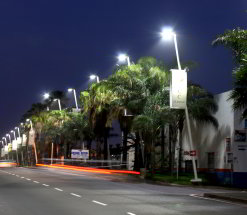Mass Rollout of CFLs
1. Objectives of the Projects
South Africa is one of the countries globally that has electricity capacity issues. Replacing inefficient incandescent light bulbs with CFL light bulbs has resulted in reduced peak demand on the grid and also resulted in reduced energy consumption for the end – user. Since South Africa has a largely coal fired generation base the resulting environmental impacts are significant. The scope of work was the following : Design the rollout methodology process, propose the measurement model based on IPMVP standards, design and manage the rollout structure of the project including specifying and procuring the equipment and subcontractors. A full end to end process with documentation was also created to manage this process – this process was designed to create reporting information but also to detect fraud in the system. The end result of this project has been a reduction of more than 1600 MW of peak demand on the South African network. This is an independently verified figure.
2. Methodolody
The concept of changing a light bulb is very simple and therefore those who have not had any experience in implementing a project of this nature tend to under-estimate the logistics and processes that need to be in place for the intended light bulb to end up in the corresponding light point. The program and processes that have been developed are very structured and rigid and have built-in mechanisms to pick up fraud and other risks associated with a project of this nature. The aim of the intervention is to guarantee that all the bulbs end up in the intended sockets and to have a clearly defined audit trail for each bulb.
In addition to having a clearly defined audit trail for each bulb, serious consideration needs to be given to the mechanism that would allow this switch to take place. There are two mechanisms that are favoured and have found to work from past experience, namely:
- Door to Door Exchange (D2D)
- Community Based Exchange Points (CBEP)
The door to door distribution will entail field workers going from house to house and physically exchanging the lamps in the sockets to ensure maximum impact. The areas where access during work hours will be restricted and hence hamper a door to door effort, have been earmarked for CBEP. The main reason for this is that a door-to-door campaign will not be effective in all areas due to the fact that in some areas access during working hours is restricted due to the occupants being at work / school etc and for this reason it was decided that it would be more effective to have the resident come to us at his convenience.
The Community Based Exchange Point (CBEP) is used in areas where access or ease of access in the household is found to be a problem. It has been found that a Door to Door Exchange works best in the lower income areas whereas the medium to higher income areas are more conducive to a Community Based Exchange Point. The location of the CBEP will be planned so that it is local to the area and convenient for the home-owner. Thought on how to restrict exchanges to within geographical boundaries will also have to be given so as to remove the possibility of duplication in exchanges. Marketing campaigns will spear-head both campaigns to inform residents of their respective modes of exchange and the criteria for exchange.
3. How the Project Makes a Contribution to Energy Efficiency and Renewable Energy
- Eskom has been struggling to meet peak demand requirements on the grid. The options were to put in very expensive supply side options like the OCGT plants or sculpt the electricity profile using demand side management (DSM) techniques
- DSM techniques are generally quick to implement and cost substantially less to implement than new plant.
- These DSM techniques are not meant to permanently address the problem but it does buy time to address the problem on a more permanent basis.
4. List of the Past and Future Actions, deliverables and Milestones of this Project
| Execution Date | Description of Works / Role in the Action | Location | No of Lamps | No of Households Visited | Peak Demand Reduction – MW |
| 2004 | Professional Services – Mass Rollout of Energy Efficient CFLs | National Pilot | 3 000 000,00 | 500 000,00 | 105,00 |
| 2005 | Project Management Services – Mass Rollout of Energy Efficient Lamps | Kwa Zulu Natal Rollout | 4 224 100,00 | 528 012,50 | 147,84 |
| 2006 | Turnkey Rollout – CFL Lamps in Western Cape | Western Cape | 5 229 086,00 | 653 635,75 | 183,02 |
| 2006 | Project Management Services – Mass Rollout of Energy Efficient Lamps | National Rollout | 2 500 000,00 | 312 500,00 | 87,50 |
| 2007 | Project Management Services – Mass Rollout of Energy Efficient Lamps | National Rollout | 8 000 000,00 | 1 000 000,00 | 280,00 |
| 2008 | Project Management Services – Mass Rollout of Energy Efficient Lamps | National Rollout | 14 200 000,00 | 1 775 000,00 | 497,00 |
| 2009 | Project Management Services – Mass Rollout of Energy Efficient Lamps | National Rollout | 8 000 000,00 | 1 000 000,00 | 280,00 |
| 2010 | Turnkey Rolllout – CFL Lamps in Gauteng | Gauteng | 1 100 000,00 | 137 500,00 | 38,50 |
| TOTAL | 45 153 186,00 | 5 906 648,25 | 1 618,86 | ||
5. Karebo Summary
In 2004, Eskom needed a framework to be able to rollout CFLs to reduce peak demand in an efficient and uniform way. The requirement for uniformity was to reduce the costs of measurement and verification. All of these boxes were ticked and this framework allowed Eskom to derive a massive benefit for a relatively low cost. This strategy seems to be in favour again – it was ditched in the dark days of state capture in favour of running the OCGTs as much as possible – at Eskom now that the focus is back on managing the grid in an effective manner.
PROJECT IN ONE SENTENCE
An efficient and effective way to do a mass rollout of CFLs.



